|
===================================================
How To Break 80 Newsletter
November 22, 2006
"The Web's Most Popular Golf Improvement Newsletter"
===================================================
In this issue we'll discuss...
1) Sticking the Half-wedge Shot
2) Matching Ball Position to Putting Stroke
3) Question of the Week- Loss of Power
4) Article- Four Approaches to Club Fitting
5) Article- The Four Basics of Any Golf Swing
===================================================
1) Sticking the Half-wedge Shot
===================================================
Not every weekend golfer is comfortable hitting a half-wedge to the green. Many lack confidence in the shot, causing them to mis-hit it. Instead of using it when it’s called for, they opt for another shot they have more confidence in, but that doesn’t provide the benefits of the half-wedge.
But if you’re serious about reducing your golf handicap, mastering this shot is a good beginning. When hit correctly, it turns three shots into two. Ideal from about 60 yards, a good half-wedge sticks the ball close to the pin, setting you up for a very makeable putt—and maybe a birdie.
The key to the shot is how you hit it. Many golfers hit it incorrectly. They set up like it’s just another shot, then try to limit their power by easing up at impact. Anytime you decelerate through impact, you run the risk of mis-hitting the ball. In this case, doing so could cause you to miss a golden opportunity to hit the green.
Instead, try this. Dial in distance by varying how much you choke up on the club. That way you can always take the same swing, regardless of the distance. If you have to choke down five inches to cut your swing in half, so be it. Just take a few practice swings to get comfortable with the shorter club.
Gripping down is a good way to reduce distance, but so is limiting your backswing. If you hit a full wedge 90 yards, a three-quarter swing should produce a shot of about 60 yards, and a half-swing should make the ball go about 45. To guard against hitting the ball fat, start the downswing by opening up your left hip (right-handers) first, then letting your arms and the club follow.
Either approach to hitting the half-wedge works. It’s just a question of which you’re most comfortable with. Test both to see which you like the best. Then practice it until you’ve ingrained it. You’ll be surprised how handy this shot can be.
=================================================== 2)
Matching Ball Position to Putting Stroke
===================================================
Putting isn’t quite as easy as the pros sometimes make it seem. Even if you do everything right—a perfect read, a pure stroke, an ideal ball speed—you can still miss a putt if the position of your ball is off. Matching ball position to your stroke can be a key to putting success.
How important is ball position? Oliver Heuler, in his book on the basics of the short game, says that incorrect ball position is one of the four most frequent mistakes a golfer makes when putting—the other three being the position of the hands, head and body movement, and wrist involvement. Ask a good putter and he or she will probably confirm Heuler’s statement.
It’s critical, then, that you determine the ideal ball position for your putting stroke. Generally speaking, that position is an inch forward of the bottom of your swing arc, whatever stroke you use. That way the putter makes contact with the ball on a slight upswing, which starts the ball rolling.
Unfortunately, your swing arc changes depending on your stroke, so your ball position will also change. If you use a reverse overlapping grip with a traditional putter, the ideal ball position might be more forward in your stance. On the other hand, if you use a conventional grip with a belly putter, the ideal ball position might be more toward the middle of your stance.
How do you determine the right ball position for your stroke? One way is to take your stance, lift your putter off the ground, and repeat your stroke over and over with your eyes shut. After a few repetitions, lower your stroke gently until you feel the putter just brush the grass. Ask a friend to mark the shot. Then measure one inch from it. That’s your ideal ball position.
Try this little exercise next time you’re with a golfing buddy and see how it works. Finding the ideal ball position for your putting stroke might just make you a better putter.
=================================================== 3)
Question of the Week- Loss of Power
===================================================
From EK
Loss of Power
Q. Hi Jack.
I've read all your e-mails and I appreciate your instructions. I seem to have lost a lot of distance with my clubs. I guess this is due to my age, which is 76. Perhaps as my friends say my swing is “all arms.” There’s no weight transfer, which I attribute to my age as well. Is there any other way to get more distance at my age?
A. Thanks for the question. Loss of distance is common with senior players, but it can affect everyone. The fixes below will help.
As golfers get older, they relinquish flexibility, which means their swings get shorter and they lose power. First, work on your body. Hook a broom handle behind your back and hold it in place with your arms. Rotate to the right and hold for a count of seven. Then rotate to the left and do the same. Work on this five minutes a day. Eventually, your flexibly will increase.
Second, work on your swing. You need to learn to complete your backswing and get the club releasing and accelerating on an inside path back to the ball. Here’s how:
Stand with your feet fairly close together, then pull your right foot and hip back (right-handers) until your body is in a closed position. This will help you turn your right side out of the way on the backswing. Now with the ball back a little in your stance, take a swing. Don’t be afraid to raise your left heel or allow your left arm to bend a little to complete your backswing. The relaxed position at the top allows you to move through the ball freely and use your hands and arms to snap the clubhead through, striking the ball solidly.
If you've got a golf question you'd like answered, send an email to us at
questions@howtobreak80.com and we'll review it. I can't guarantee that we'll use it but if we do, we'll make sure to include your name and where you're from.
===================================================
If you want to truly discover the secrets of shooting like the Pros and creating a more reliable and consistent swing, check out:
http://www.HowToBreak80.com
P.S. Feel free to share this newsletter with family and friends. If you
would like to subscribe to this newsletter, send a blank email to
break80ezine@aweber.com
===================================================
About the Author
===================================================
Jack Moorehouse is the author of the best-selling book
"How To Break 80 and Shoot Like the Pros!". He is NOT a golf pro, rather a working man that has helped thousands of golfers from all seven continents lower their handicaps quickly. His free weekly newsletter goes out to thousands of golfers worldwide and provides the latest golf tips, strategies, techniques and instruction on how to improve your golf game.
|
Tools To
Help Your Game!
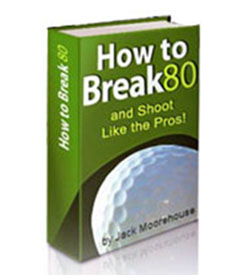
eBook
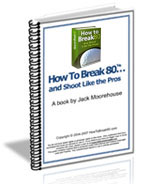
Physical Book
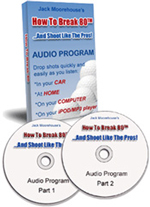
Audio Program
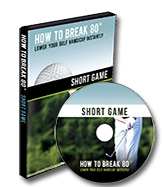
Short Game DVD
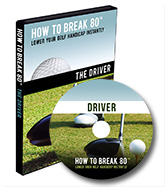
Driver DVD
|